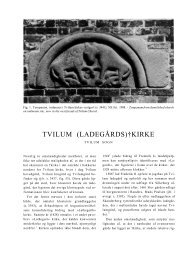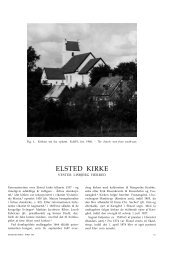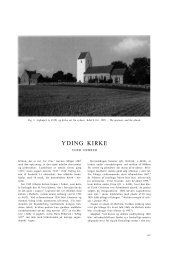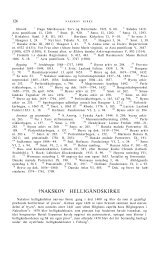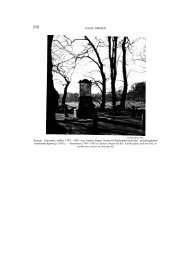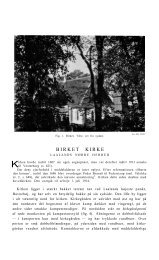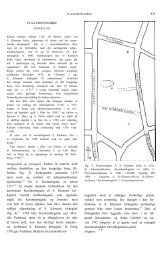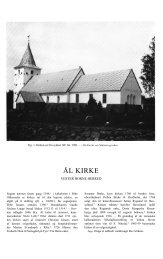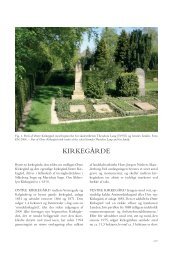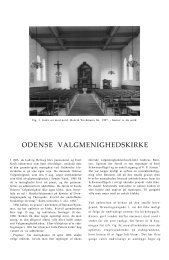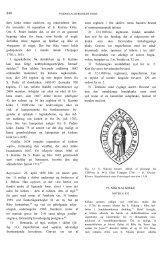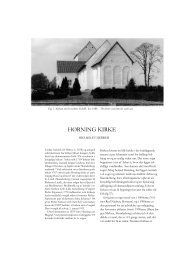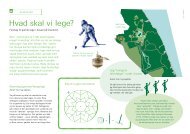Siddha Medicine in Tamil Nadu - Nationalmuseet
Siddha Medicine in Tamil Nadu - Nationalmuseet
Siddha Medicine in Tamil Nadu - Nationalmuseet
Create successful ePaper yourself
Turn your PDF publications into a flip-book with our unique Google optimized e-Paper software.
Tranquebar Initiativets<br />
S k r i f t s e r i e<br />
<strong>Siddha</strong> <strong>Medic<strong>in</strong>e</strong> <strong>in</strong> <strong>Tamil</strong> <strong>Nadu</strong><br />
KENNETH G. ZYSK<br />
Nr. 4, 2008
Tranquebar Initiativets Skriftserie, nr. 4, 2008<br />
© <strong>Nationalmuseet</strong> og Kenneth G. Zysk 2008<br />
Artiklen er skrevet på baggrund af forskn<strong>in</strong>gsprojektet<br />
”Traditionel syd<strong>in</strong>disk lægekunst i området omkr<strong>in</strong>g Tranquebar”<br />
under Galathea3. Tak til Bikubenfonden for generøs støtte til<br />
projektet.<br />
Udgivet af<br />
<strong>Nationalmuseet</strong>s Tranquebar Initiativ<br />
Etnografisk Saml<strong>in</strong>g<br />
<strong>Nationalmuseet</strong><br />
Frederiksholms Kanal 12<br />
1220 København K<br />
Ansvarshavende redaktør<br />
Esther Fihl, professor, professor, dr.phil.<br />
Medredaktør<br />
Ulf Johansson Dahre, , over<strong>in</strong>spektør, over<strong>in</strong>spektør, dr.<br />
Artiklen er peer reviewed<br />
Layout<br />
Simon Rastén<br />
Illustrationer<br />
Christian Sébastia<br />
Tryk<br />
LaserTryk.dk A/S<br />
Distribution<br />
Elektronisk form:<br />
http://www.tranquebar.<strong>in</strong>fo<br />
ISBN<br />
978-87-7602-101-6 (paperback)<br />
978-87-7602-102-3 (PDF)<br />
Forsideillustration<br />
Christian Sébastia
English abstract<br />
The author presents a detailed <strong>in</strong>sight <strong>in</strong>to the pr<strong>in</strong>ciples and<br />
practices of the <strong>Tamil</strong> medical tradition of <strong>Siddha</strong>. <strong>Siddha</strong>’s history<br />
along with its pr<strong>in</strong>ciples of diagnosis and treatment is compared<br />
to that of north India’s Ayurvedic medical tradition. In this way,<br />
both traditions of Indian medic<strong>in</strong>e are understood <strong>in</strong> relationship<br />
to one another.<br />
Tradition attributes a div<strong>in</strong>e orig<strong>in</strong> to <strong>Siddha</strong> medic<strong>in</strong>e. Both<br />
the universe and the human body derive from the same five basic<br />
elements: w<strong>in</strong>d, space/ether, fire, water, and earth. They comb<strong>in</strong>e<br />
to provide each <strong>in</strong>dividual with his or her unique configuration of<br />
the three basic humours or doshas <strong>in</strong> human be<strong>in</strong>gs: w<strong>in</strong>d, bile,<br />
and phlegm, called the person’s basic nature. A skilled physician<br />
uses various methods, <strong>in</strong>clud<strong>in</strong>g the exam<strong>in</strong>ation of the patient’s<br />
pulse and ur<strong>in</strong>e, to diagnose an imbalance <strong>in</strong> the patient’s basic<br />
nature. Treatment, aimed at the restoration of the imbalance,<br />
<strong>in</strong>volves the use of plant-based and especially metal- and m<strong>in</strong>eral-<br />
based medic<strong>in</strong>es, which are said to be imbued with an esoteric<br />
substance called muppu.<br />
The article concludes with a discussion of <strong>Siddha</strong> medic<strong>in</strong>e’s<br />
uncerta<strong>in</strong> orig<strong>in</strong>s and its place <strong>in</strong> the contemporary world of medi-<br />
c<strong>in</strong>e.
Tranquebar Initiativet<br />
Dansk resumé<br />
<strong>Siddha</strong> lægevidenskaben i <strong>Tamil</strong> <strong>Nadu</strong>.<br />
I artiklen ’<strong>Siddha</strong> <strong>Medic<strong>in</strong>e</strong> <strong>in</strong> <strong>Tamil</strong> <strong>Nadu</strong>’ giver forfatteren et de-<br />
taljeret <strong>in</strong>dblik i pr<strong>in</strong>cipperne bag den traditionelle tamilske læge-<br />
videnskab <strong>Siddha</strong>. Gennem en sammenlign<strong>in</strong>g med den old<strong>in</strong>diske<br />
lægevidenskab Ayurveda, præsenteres <strong>Siddha</strong> medic<strong>in</strong>ens histo-<br />
rie samt pr<strong>in</strong>cipperne bag diagnosticer<strong>in</strong>g og behandl<strong>in</strong>g. Desuden<br />
sættes opskrifter på medic<strong>in</strong> i relation til det verdensbillede, <strong>in</strong>den<br />
for hvilken medic<strong>in</strong>en forstås.<br />
<strong>Siddha</strong> medic<strong>in</strong>ens udøvere tilskriver den en guddommelig<br />
opr<strong>in</strong>delse. Både universet og menneskekroppen stammer fra de<br />
samme elementer: v<strong>in</strong>d, ild, æter, jord og vand, og de forskellige<br />
elementer tilskrives under<strong>in</strong>ddel<strong>in</strong>g efter under<strong>in</strong>ddel<strong>in</strong>g, <strong>in</strong>dtil<br />
en kompleks lægevidenskabelig kosmologi tegner sig og danner<br />
grundlaget for behandl<strong>in</strong>g.<br />
Diagnosticer<strong>in</strong>gen foregår ved en vurder<strong>in</strong>g af patientens<br />
unikke sammensætn<strong>in</strong>g af v<strong>in</strong>d, galde og flegma, som på tamilsk<br />
er komb<strong>in</strong>ationer af jord, vand, ild, v<strong>in</strong>d og æter. For at f<strong>in</strong>de frem<br />
til en prognose og diagnose benytter <strong>Siddha</strong> læger blandt andet<br />
puls- og ur<strong>in</strong>undersøgelser. Behandl<strong>in</strong>gen tager udgangspunkt i<br />
alkymi, plantemedic<strong>in</strong>, og et magisk sammensat stof, som på ta-<br />
milsk kaldes muppu. Tilsammen bruges dette både til at helbrede,<br />
og især til at forebygge sygdomme.<br />
Artiklen afsluttes med en diskussion af <strong>Siddha</strong> lægeviden-<br />
skabens usikre opr<strong>in</strong>delse og dens rolle og udbredelse i verden i<br />
dag.<br />
Tranquebar Initiativets<br />
S k r i f t s e r i e
<strong>Siddha</strong> <strong>Medic<strong>in</strong>e</strong> <strong>in</strong> <strong>Tamil</strong> <strong>Nadu</strong><br />
KENNETH G. ZYSK<br />
Lektor, ph.d., dr.phil., Afdel<strong>in</strong>g for Asiensstudier<br />
Institut for Tværkulturelle og Regionale Studier<br />
Københavns Universitet<br />
Tranquebar Initiativets Skriftserie, nr. 4, 2008
<strong>Siddha</strong> <strong>Medic<strong>in</strong>e</strong> <strong>in</strong> <strong>Tamil</strong> <strong>Nadu</strong><br />
Introduction<br />
Three traditional medic<strong>in</strong>al systems predom<strong>in</strong>ate <strong>in</strong> modern India: Ayurveda,<br />
<strong>Siddha</strong>, and Unani. Ayurveda is found mostly <strong>in</strong> northern India and <strong>in</strong> Kerala<br />
<strong>in</strong> the south, <strong>Siddha</strong> medic<strong>in</strong>e occurs <strong>in</strong> <strong>Tamil</strong> <strong>Nadu</strong> and parts of Kerala,<br />
and Unani, which derives from Arabic medic<strong>in</strong>e, is found throughout India,<br />
ma<strong>in</strong>ly <strong>in</strong> the urban areas. This essay focuses on <strong>Siddha</strong> medic<strong>in</strong>e (<strong>Tamil</strong>: Citta<br />
Vaittiyam) and its history and practice <strong>in</strong> South India, with an eye towards the<br />
similarities and differences between <strong>Siddha</strong> medic<strong>in</strong>e and Ayurveda.<br />
Research <strong>in</strong>to <strong>Siddha</strong> medic<strong>in</strong>e <strong>in</strong> <strong>Tamil</strong> <strong>Nadu</strong> has revealed certa<strong>in</strong> difficulties<br />
which must be overcome <strong>in</strong> order to understand properly this medical<br />
system and its history. The central problem lies with the reliability of the<br />
secondary sources, which are written primarily by <strong>Tamil</strong> <strong>Siddha</strong> doctors. Very<br />
little scholarship on the subject has been carried out by western students and<br />
scholars of India and Indian medic<strong>in</strong>e.<br />
Due to the <strong>in</strong>creased awareness of <strong>Tamil</strong>’s Dravidian l<strong>in</strong>gusitic roots over<br />
the past decades, a strong nationalist movement has grown up <strong>in</strong> <strong>Tamil</strong> <strong>Nadu</strong>.<br />
<strong>Tamil</strong>ians consider their cultural and l<strong>in</strong>guistic heritage to be older and more<br />
important than that of the Indo-Aryans of northern India; some even claim<br />
their ancestors were the first civilised humans on the planet. The fire of this<br />
controversy has recently been k<strong>in</strong>dled by a debate centr<strong>in</strong>g on the still-to-bedeciphered<br />
script of the so-called Indus Valley Civilisation. This ancient urban<br />
culture, which extended along the Indus River and its tributaries <strong>in</strong> what is now<br />
Pakistan, resembled the great civilisations of ancient Egypt and Mesopotamia<br />
<strong>in</strong> size, development and age. One side of the debate ma<strong>in</strong>ta<strong>in</strong>s that the script<br />
represents a language probably of Dravidian orig<strong>in</strong>, while the other side<br />
claims that it does not represent a language at all. <strong>Tamil</strong>ians, whose language is<br />
Dravidian, are anxiously follow<strong>in</strong>g the debate, for if the former side prevails,<br />
it would confirm their antiquity on the Indian subcont<strong>in</strong>ent. The lens through<br />
which <strong>Tamil</strong>ians look at their own history will always distort the image <strong>in</strong> favour<br />
of <strong>Tamil</strong> superiority and antiquity.<br />
History<br />
References to Ayurveda occur early <strong>in</strong> <strong>Tamil</strong> literature. Already <strong>in</strong> the mid-fifth<br />
century C.E. text, Cilappatikara, there is reference to Ayurveda (<strong>Tamil</strong>: āyulvetar).<br />
Mention of the three humours (<strong>Tamil</strong>: tiritocam, Sanskrit. tridosha) occurs <strong>in</strong> the<br />
Tirukural, a collection of poems that dates from around 450-550 C.E.<br />
The first <strong>Tamil</strong> <strong>Siddha</strong> text is the Tirumandiram written by Tirumular and
KENNETH G. ZYSK<br />
dated probably to around the 6 th or 7 th century C.E. In it there is mention of<br />
alchemy used to transform iron <strong>in</strong>to gold; but no specific references to <strong>Tamil</strong><br />
medic<strong>in</strong>al doctr<strong>in</strong>es are found. The major sources of <strong>Siddha</strong> medic<strong>in</strong>e belong<br />
to religious groups who call themselves Kayasiddhas. They emphasised the<br />
“perfection of the body” by means of yoga, alchemy, medic<strong>in</strong>e, and certa<strong>in</strong><br />
types of Tantric religious rituals. Their works date from about the 13 th to the<br />
14 th century C.E., and are attributed to numerous authors <strong>in</strong>clud<strong>in</strong>g Akattiyar<br />
(Sanskrit: Agastya), the traditional founder of <strong>Siddha</strong> medic<strong>in</strong>e and Teraiyar<br />
(c. late 17 th century), who is said to have written twelve works on medic<strong>in</strong>e,<br />
and whose famous disciple Iramatevar travelled to Mecca <strong>in</strong> the late 17 th or<br />
early 18 th century where he studied, converted to Islam, and took on the name<br />
Yakkopu (i.e., Jacob). Most critical scholars of <strong>Siddha</strong> agree that on the basis<br />
of their language, the numerous texts on <strong>Siddha</strong> medic<strong>in</strong>e, which present it as<br />
a system of heal<strong>in</strong>g, cannot be older than the 16 th century. We must, therefore,<br />
acknowledge that <strong>Tamil</strong> <strong>Siddha</strong> medic<strong>in</strong>e, as it is now exists <strong>in</strong> both theory and<br />
practice, began <strong>in</strong> <strong>Tamil</strong> <strong>Nadu</strong> around the 16 th century, but elements of heal<strong>in</strong>g<br />
practices which became part of <strong>Siddha</strong> medic<strong>in</strong>e, <strong>in</strong>clud<strong>in</strong>g those they hold <strong>in</strong><br />
common with Ayurveda, came from an earlier period.<br />
<strong>Tamil</strong> folklore surround<strong>in</strong>g heal<strong>in</strong>g shares a common orig<strong>in</strong> with Buddhism<br />
from northern India. In order to trace the orig<strong>in</strong> of the name Teraiyar, legend<br />
says that the Akattiyar performed a treph<strong>in</strong>ation on a sage <strong>in</strong> order to remove<br />
a toad (terai) from <strong>in</strong>side his skull. However, it was Akattiyar’s disciple who,<br />
with an <strong>in</strong>strument, made the frog jump <strong>in</strong>to a bowl of water. Because of his<br />
skill <strong>in</strong> remov<strong>in</strong>g the toad, Akattiyar gave the disciple the name Teraiyar who<br />
is, however, a different person from the late 17 th century medical author of the<br />
same name.<br />
This is a particularly <strong>in</strong>terest<strong>in</strong>g legend because there is a similar account <strong>in</strong><br />
Buddhist literature. In its earliest version found <strong>in</strong> the Pali texts of the Buddhist<br />
Canon, a skilled physician, Jivaka Komarabhacca, opened up the skull of a<br />
merchant from Rajagriha and removed two centipedes by touch<strong>in</strong>g them with<br />
a hot poker. The merchant made a full recovery. Versions of this folk story occur<br />
<strong>in</strong> the Sanskrit literature of later Mahayana Buddhism and were translated<br />
<strong>in</strong>to Tibetan and Ch<strong>in</strong>ese. The uniqueness of the story as a remarkable medical<br />
accomplishment and its spread throughout Buddhist Asia testifies to the <strong>in</strong>fluence<br />
of Buddhism <strong>in</strong> the dissem<strong>in</strong>ation of medical knowledge <strong>in</strong> pre-modern<br />
India.<br />
Like all systems of H<strong>in</strong>du knowledge, <strong>Siddha</strong> medic<strong>in</strong>e attributes its orig<strong>in</strong>
<strong>Siddha</strong> <strong>Medic<strong>in</strong>e</strong> <strong>in</strong> <strong>Tamil</strong> <strong>Nadu</strong><br />
<strong>Siddha</strong> medical manuscripts <strong>in</strong> <strong>Tamil</strong>.<br />
to a div<strong>in</strong>e source; hence its knowledge is sacred and eternal, passed down<br />
to humans for the benefit of all humanity. Accord<strong>in</strong>g to H<strong>in</strong>du tradition, the<br />
god Shiva transmitted the knowledge of medic<strong>in</strong>e to his wife Parvati, who <strong>in</strong><br />
turn passed it on to Nandi, from whom it was given to the first practitioners<br />
of <strong>Siddha</strong> medic<strong>in</strong>e, the <strong>Siddha</strong>rs. Tradition lists a total number of eighteen<br />
<strong>Siddha</strong>rs, beg<strong>in</strong>n<strong>in</strong>g with Nandi and the semi-legendary Agattiyar through to<br />
the f<strong>in</strong>al <strong>Siddha</strong>r, Kudhambai. 1 They are the acknowledged transmitters of<br />
<strong>Siddha</strong> medical doctr<strong>in</strong>es and practices. By attribut<strong>in</strong>g a div<strong>in</strong>e or extra-human<br />
orig<strong>in</strong> to its medic<strong>in</strong>e, the <strong>Tamil</strong> <strong>Siddha</strong>rs have assured <strong>Siddha</strong> medic<strong>in</strong>e a legitimate<br />
place <strong>in</strong> the corpus of H<strong>in</strong>du knowledge. Although the transmission<br />
beg<strong>in</strong>s with Nandi, who <strong>in</strong> the form of a bull is Shiva’s mode of transportation,<br />
tradition attributes the orig<strong>in</strong> of medic<strong>in</strong>e as well as of the <strong>Tamil</strong> language to<br />
Agattiyar.<br />
The pr<strong>in</strong>ciples of <strong>Siddha</strong> medic<strong>in</strong>e<br />
Accord<strong>in</strong>g to <strong>Siddha</strong> cosmology, all matter is composed of two primal forces<br />
of matter (shiva) and energy (shakti). These two pr<strong>in</strong>ciples of existence operate<br />
<strong>in</strong> humans as well as nature, and connect the microcosm with the macrocosm.<br />
This is expressed by the association between the human body and the signs of<br />
the zodiac <strong>in</strong> Indian astrology. The formulation of the sequence of body parts<br />
is <strong>in</strong>terest<strong>in</strong>g because it follows a Babylonian and Greco-Roman system of<br />
head-to-toe rather than an Indian one, which beg<strong>in</strong>s at the toes and ends at the<br />
1 Accord<strong>in</strong>g to one tradition, the <strong>Siddha</strong>rs are Nandi, Agasthiyar, Tirumular, Punnakkeesar,<br />
Pulasthiyar, Poonaikannar, Idaikkadar, Bogar, Pulikaisar, Karuvurar, Konkanavar, Kalangi,<br />
Satta<strong>in</strong>athar, Azhuganni, Agappai, Pumbatti, Theraiyar and Kudhambai. Other traditions<br />
give a slightly different sequence of enumeration.<br />
(Photos: Christian Sébastia)<br />
<strong>Siddha</strong>r: Agattiyar (Agastya).
KENNETH G. ZYSK<br />
head. This is illustrated <strong>in</strong> the follow<strong>in</strong>g list, us<strong>in</strong>g Lat<strong>in</strong>-based zodiac names.<br />
1. ♈ Áries (0°)= the neck<br />
2. ♉ Taurus (30°)= the shoulders<br />
3. ♊ Gém<strong>in</strong>i (60°)= the arms and hands<br />
4. ♋ Cancer (90°)= the chest<br />
5. ♌ Leo (120°)= the heart and the stomach<br />
6. ♍ Virgo (150°)= the <strong>in</strong>test<strong>in</strong>es<br />
7. ♎ Libra (180°)= the kidneys<br />
8. ♏ Scórpio (210°)= the genitals<br />
9. ♐ Sagittárius (240°)= the hips<br />
10. ♑ Capricornus (270°)= the knees<br />
11. ♒ Aquárius (300°)= the legs<br />
12. ♓ Pisces (330°)= the feet<br />
In addition to this cosmic connection which occurred <strong>in</strong> all traditions of<br />
Indian astrology, <strong>Siddha</strong> medic<strong>in</strong>e relied entirely on Ayurveda for the medical<br />
doctr<strong>in</strong>es that bridge the natural world and the human body. In modern day<br />
<strong>Siddha</strong> practice, evidence of the follow<strong>in</strong>g epistemology is not always noticed.<br />
First, there are the five gross elements (pañcamahabhutam), which make up<br />
the entire natural world: solid/earth, fluid/water, radiance/fire, gas/w<strong>in</strong>d, and<br />
ether/space. These comb<strong>in</strong>e <strong>in</strong> certa<strong>in</strong> ways to give the three bodily humours,<br />
called mupp<strong>in</strong>i <strong>in</strong> modern <strong>Tamil</strong>. They are said to be <strong>in</strong> the proportion of 1 w<strong>in</strong>d<br />
to ½ bile to ¼ phlegm, which is opposite to that found <strong>in</strong> Ayurveda:<br />
1. W<strong>in</strong>d (<strong>Tamil</strong>: vatham, Sanskrit: vata) is a comb<strong>in</strong>ation of space and w<strong>in</strong>d,<br />
and is responsible for nervous actions, movement, activity, sensations,<br />
etc. It is found <strong>in</strong> the form of the five bodily w<strong>in</strong>ds.<br />
2. Bile (<strong>Tamil</strong>: pittam, Sanskrit: pitta) is made up of fire alone and takes care<br />
of metabolism, digestion, assimilation, warmth, etc. Its pr<strong>in</strong>cipal seat is<br />
<strong>in</strong> the alimentary canal from the cardiac region to small <strong>in</strong>test<strong>in</strong>es. Some<br />
Ayurvedic formulations state that bile is a comb<strong>in</strong>ation of the elements<br />
fire and water.<br />
3. Phlegm (<strong>Tamil</strong>: siletuman, Sanskrit: shleshman, kapha) is a comb<strong>in</strong>ation of<br />
earth and water and is responsible for stability <strong>in</strong> the body. Its pr<strong>in</strong>cipal<br />
seats are <strong>in</strong> the chest, throat, head, and jo<strong>in</strong>ts.
<strong>Siddha</strong> <strong>Medic<strong>in</strong>e</strong> <strong>in</strong> <strong>Tamil</strong> <strong>Nadu</strong><br />
Next, there is the shared doctr<strong>in</strong>e of the seven tissues (<strong>Tamil</strong>: dhatu) of the<br />
body: lymph/chyle, blood, muscle, fat, bone, marrow, and sperm and ovum.<br />
F<strong>in</strong>ally, there are the five w<strong>in</strong>ds (<strong>Tamil</strong>: vatham, Sanskrit: prana) which circulate<br />
<strong>in</strong> the body and <strong>in</strong>itiate and carry out bodily functions: pranam is the <strong>in</strong>haled<br />
breath and br<strong>in</strong>gs about swallow<strong>in</strong>g; apanam is the exhaled breath and is responsible<br />
for expulsion, ejection and excretion; samanam helps digestion; vyanam aids<br />
circulation of blood and nutrients; and udanam functions <strong>in</strong> the upper respiratory<br />
passages. There are also five secondary w<strong>in</strong>ds: nagam, the air of higher <strong>in</strong>tellectual<br />
functions; kurmam, the air of yawn<strong>in</strong>g; kirukaram, the air of salivation;<br />
devadhattham, the air of laz<strong>in</strong>ess; and dhananjayam, the air that acts on death.<br />
Like Ayurveda, <strong>Siddha</strong> medic<strong>in</strong>e ma<strong>in</strong>ta<strong>in</strong>s that the three humours predom<strong>in</strong>ate<br />
<strong>in</strong> humans <strong>in</strong> accordance with their nature and stage of life, and that they<br />
vary with the seasons. Every <strong>in</strong>dividual is born with a unique configuration<br />
of the three humours, which is called the <strong>in</strong>dividual’s basic nature (Sanskrit:<br />
prakriti). It is fixed at birth and forms the basis of his or her normal, healthy<br />
state. However, dur<strong>in</strong>g the three different stages of life and dur<strong>in</strong>g the different<br />
seasons, one humour usually predom<strong>in</strong>ates, which is normal, but such a<br />
dom<strong>in</strong>ation of a humour must be understood <strong>in</strong> relation to the person’s fundamental<br />
nature <strong>in</strong> order to ma<strong>in</strong>ta<strong>in</strong> the balance that is the <strong>in</strong>dividual’s basic<br />
state. The classification of the humours accord<strong>in</strong>g to stages of life and seasons<br />
<strong>in</strong> <strong>Siddha</strong> differs from that found <strong>in</strong> Ayurveda. In the case of the seasons, the<br />
variation is attributed simply to the different climatic conditions that occur <strong>in</strong><br />
the different parts of the year <strong>in</strong> the northern <strong>in</strong>land areas and the southern,<br />
<strong>Tamil</strong> coastal and <strong>in</strong>land environments.<br />
Accord<strong>in</strong>g to <strong>Siddha</strong>, w<strong>in</strong>d predom<strong>in</strong>ates <strong>in</strong> the first third of life, bile <strong>in</strong> the<br />
second third, and phlegm <strong>in</strong> the last third of life, while <strong>in</strong> Ayurveda phlegm<br />
dom<strong>in</strong>ates the first third and w<strong>in</strong>d the last third of life. In terms of climate the<br />
north is colder <strong>in</strong> the w<strong>in</strong>ter (Dec.-Jan.) than is the south and the west coast has<br />
ra<strong>in</strong> <strong>in</strong> June and July, when the east coast is extremely hot. A dry, cold climate is<br />
rare <strong>in</strong> the south, but it is precisely that climate which <strong>in</strong>creases w<strong>in</strong>d. Bile and<br />
phlegm, on the other hand, are <strong>in</strong>creased when it is hot and wet.<br />
Diagnosis <strong>in</strong> <strong>Siddha</strong> medic<strong>in</strong>e<br />
The diagnosis of disease <strong>in</strong> <strong>Siddha</strong> medic<strong>in</strong>e relies on the exam<strong>in</strong>ation of eight<br />
anatomical features (envagi thaervu), which are evaluated <strong>in</strong> terms of the three<br />
humours:
KENNETH G. ZYSK<br />
1. the tongue: black <strong>in</strong>dicates w<strong>in</strong>d, yellow or red bile, and white phlegm;<br />
an ulcerated tongue po<strong>in</strong>ts to anaemia;<br />
2. the complexion: dark <strong>in</strong>dicates w<strong>in</strong>d, yellow or red bile, and pale<br />
phlegm;<br />
3. the voice: normal <strong>in</strong>dicates w<strong>in</strong>d, high pitched bile, and low pitched<br />
phlegm;<br />
4. the eyes: muddy coloured <strong>in</strong>dicates w<strong>in</strong>d, yellowish or red bile, and pale<br />
phlegm;<br />
5. the touch: dryness <strong>in</strong>dicates w<strong>in</strong>d, warmness bile, and cold, clammy<br />
phlegm;<br />
6. the stool: black <strong>in</strong>dicates w<strong>in</strong>d, yellow bile, and pale phlegm;<br />
7. the pulse (see below); and<br />
8. the ur<strong>in</strong>e (see below).<br />
Most modern <strong>Siddha</strong> doctors place the greatest emphasis on the exam<strong>in</strong>ation<br />
of the pulse, whereby both diagnosis and prognosis can be obta<strong>in</strong>ed<br />
through one process. These methods of diagnosis also occur <strong>in</strong> Ayurveda, but<br />
only after the 14 th century. Prior to this time and <strong>in</strong> the Ayurvedic classical literature,<br />
diagnosis of disease was determ<strong>in</strong>ed by a vitiation of one or more of<br />
the humours based on observation, touch and <strong>in</strong>terrogation.<br />
<strong>Siddha</strong> pulse diagnosis (<strong>Tamil</strong>: natiparitchai, Sanskrit: nadipariksha), like<br />
that found <strong>in</strong> Ayurveda, <strong>in</strong> all probability owes it orig<strong>in</strong>s to Unani medic<strong>in</strong>e.<br />
Moreover, it requires a highly developed sense of touch and a ref<strong>in</strong>ed subjective<br />
awareness. Accord<strong>in</strong>g to <strong>Siddha</strong>, the follow<strong>in</strong>g four conditions must not be<br />
present <strong>in</strong> the patient when do<strong>in</strong>g a read<strong>in</strong>g of the pulse:<br />
1. oily hands,<br />
2. a full stomach or hunger,<br />
3. physical exhaustion, and<br />
4. emotional distress.<br />
Moreover, if a read<strong>in</strong>g cannot be taken on the hand, other arterial po<strong>in</strong>ts<br />
may be used, such as the ankle, neck, or ear lobes. It is also advisable to read<br />
the pulse at different times of the day and dur<strong>in</strong>g different seasons of the year,<br />
s<strong>in</strong>ce the body and the m<strong>in</strong>d change dur<strong>in</strong>g the course of the day and climatic<br />
conditions affect the person’s psychological and physiological states.<br />
The pulse is felt on the female’s left and male’s right hand by the doctor’s
<strong>Siddha</strong> <strong>Medic<strong>in</strong>e</strong> <strong>in</strong> <strong>Tamil</strong> <strong>Nadu</strong><br />
(Photos: Christian Sébastia)<br />
Pulse diagnosis: Male. Pulse diagnosis: Placement of f<strong>in</strong>gers.<br />
opposite hand, a couple of centimetres below the wrist jo<strong>in</strong>t us<strong>in</strong>g the <strong>in</strong>dex,<br />
middle, and r<strong>in</strong>g f<strong>in</strong>gers of the hand. Pressure should be applied by one f<strong>in</strong>ger<br />
after the other beg<strong>in</strong>n<strong>in</strong>g with the <strong>in</strong>dex f<strong>in</strong>ger. Each f<strong>in</strong>ger detects a particular<br />
humour which <strong>in</strong> normal conditions has a movement representative of certa<strong>in</strong><br />
animals. The <strong>in</strong>dex f<strong>in</strong>ger feels the w<strong>in</strong>dy humour, which should have the<br />
movement of a swan, a cock, or a peacock; the middle f<strong>in</strong>ger feels the bilious<br />
humour, which should have the movement of a tortoise or a leach; and r<strong>in</strong>g f<strong>in</strong>ger<br />
feels the phlegmatic humour, which should have the movement of a frog or<br />
a snake. Any deviation from these normal movements <strong>in</strong>dicates which humour<br />
or humours are disturbed. If all humours are affected the pulse is usually rapid<br />
with a good deal more volume than normal. After long periods of practice<br />
under the guidance of a skilled teacher, a student can beg<strong>in</strong> to detect subtle<br />
differences <strong>in</strong> the flow, volume, and speed of the pulse at the po<strong>in</strong>t of each of<br />
the three f<strong>in</strong>gers. These changes correspond to abnormalities <strong>in</strong> particular parts<br />
of the body, which the skilled <strong>Siddha</strong> doctor can p<strong>in</strong>-po<strong>in</strong>t and for which the<br />
appropriate cure can be prescribed.<br />
The exam<strong>in</strong>ation of the ur<strong>in</strong>e (muthira paritchai) is another form of diagnosis<br />
<strong>in</strong> which <strong>Siddha</strong> medic<strong>in</strong>e has demonstrated particular expertise. Not an orig<strong>in</strong>al<br />
part of Ayurveda, ur<strong>in</strong>e exam<strong>in</strong>ation probably derived from Unani medic<strong>in</strong>e,<br />
where this form of diagnosis can be noticed <strong>in</strong> early Arabic and Persian<br />
medical literature. In addition to exam<strong>in</strong><strong>in</strong>g the ur<strong>in</strong>e for its colour, smell, and<br />
texture, <strong>Siddha</strong> medic<strong>in</strong>e has developed a technique for determ<strong>in</strong><strong>in</strong>g the vitiated<br />
humour by read<strong>in</strong>g the distribution of a drop of g<strong>in</strong>gili (sesame) oil added to<br />
the ur<strong>in</strong>e. The mean<strong>in</strong>g of the drop’s configuration is as follows: longitud<strong>in</strong>al<br />
dispersal <strong>in</strong>dicates w<strong>in</strong>dy humour; dispersal <strong>in</strong> a r<strong>in</strong>g, bilious humour; and lack<br />
of dispersal po<strong>in</strong>ts to phlegmatic humour. Moreover, a comb<strong>in</strong>ation of two
KENNETH G. ZYSK<br />
types of dispersal means that two humours are <strong>in</strong>volved; the slow dispersal <strong>in</strong> a<br />
circular form and a drop that forms the shape of an umbrella, a wheel, or a jasm<strong>in</strong>e<br />
or lotus blossom <strong>in</strong>dicates a favourable prognosis. If, however, the drop<br />
s<strong>in</strong>ks, spreads rapidly with froth, splits <strong>in</strong>to smaller drops and spreads rapidly,<br />
mixes with the ur<strong>in</strong>e, or spreads so that its pattern is that of an arrow, a sword,<br />
a spear, a pestle, a bull, or an elephant, the prognosis is unfavourable.<br />
F<strong>in</strong>ally, as <strong>in</strong> Ayurveda and Unani, the conditions of the eyes show which<br />
of the humours is vitiated as well as the patient’s mental and emotional state:<br />
shifty, dry eyes po<strong>in</strong>t to w<strong>in</strong>d; yellow eyes with photophobia <strong>in</strong>dicates bile;<br />
watery, oily, eyes devoid of brightness reveals that phlegm is effected; and red,<br />
<strong>in</strong>flamed eyes show that all three humours are vitiated.<br />
The pr<strong>in</strong>ciples of treatment <strong>in</strong> <strong>Siddha</strong> medic<strong>in</strong>e<br />
Accord<strong>in</strong>g to traditional <strong>Siddha</strong> th<strong>in</strong>k<strong>in</strong>g, a physician must be knowledgeable<br />
<strong>in</strong> alchemy, astrology, and philosophy; he must be able to apply <strong>in</strong>tuition and<br />
imag<strong>in</strong>ation; he must not seek fame or fortune from heal<strong>in</strong>g; he must not treat<br />
a patient before a proper diagnosis has been reached; and he must use only<br />
medic<strong>in</strong>es that he has prepared himself.<br />
Treatment and pharmaceutics are the two areas where <strong>Siddha</strong> differs considerably<br />
from Ayurveda. Like <strong>Siddha</strong> Yoga, the pr<strong>in</strong>ciple aim of <strong>Siddha</strong> medic<strong>in</strong>e<br />
is to make the body perfect and not vulnerable to decay, so that the maximum<br />
term of life can be achieved. Like Ayurveda, <strong>Siddha</strong> places emphasis on positive<br />
health, so that the object of the medic<strong>in</strong>e is disease-prevention. Beyond<br />
this fundamental agreement between the two systems, <strong>Siddha</strong> differs considerably<br />
from Ayurveda.<br />
<strong>Siddha</strong> has developed expertise <strong>in</strong> five particular branches of medic<strong>in</strong>e: general<br />
medic<strong>in</strong>e, paediatrics, toxicology, ophthalmology, and rejuvenation, while<br />
traditional Ayurveda lists the follow<strong>in</strong>g eight branches of medic<strong>in</strong>e: general<br />
medic<strong>in</strong>e, paediatrics, surgery, treatment of ailments above the neck, toxicology,<br />
treatment of mental disorders due to seizure by evil spirits, rejuvenationtherapy,<br />
and potency-therapy. Whereas Ayurveda prescribes a therapeutic regimen<br />
<strong>in</strong>volv<strong>in</strong>g the “five purify<strong>in</strong>g actions:” emetics, purgative, enemas, bloodlett<strong>in</strong>g<br />
and errh<strong>in</strong>es, <strong>Siddha</strong> employs only purgation.<br />
<strong>Siddha</strong> medic<strong>in</strong>e has excelled <strong>in</strong> ophthalmology. It has two separate treatises<br />
devoted to the treatment of n<strong>in</strong>ety-six different eye-diseases. Toxicology has<br />
formed a separate part of <strong>Siddha</strong> medic<strong>in</strong>e and seems to be closely l<strong>in</strong>ked to<br />
<strong>in</strong>digenous systems of treat<strong>in</strong>g snake bites and other forms of poison<strong>in</strong>g. It
<strong>Siddha</strong> <strong>Medic<strong>in</strong>e</strong> <strong>in</strong> <strong>Tamil</strong> <strong>Nadu</strong><br />
may have some aff<strong>in</strong>ity to the Visha Vaidya (poison-doctor) tradition practised<br />
by certa<strong>in</strong> Nambudiri Brahm<strong>in</strong>s of Kerala. Similar to this Keralan toxicological<br />
tradition, <strong>Siddha</strong> has adopted the Ayurvedic system of the three humours <strong>in</strong><br />
order to expla<strong>in</strong> the different effects of poison; but it rema<strong>in</strong>s fundamentally<br />
an <strong>in</strong>digenous and local toxicological tradition. It classifies the severity and cure<br />
by means of the number of tooth or fang marks left <strong>in</strong> the victim. Four, be<strong>in</strong>g<br />
the most severe, is <strong>in</strong>curable; and one, be<strong>in</strong>g the least severe, is cured by cold<br />
water baths and fomentation on the site of the bite.<br />
Unlike Ayurveda, <strong>in</strong> which it forms a separate school of medic<strong>in</strong>e, surgery<br />
per se is not a significant part of <strong>Siddha</strong> medic<strong>in</strong>e. Medicated oils and pastes are<br />
applied to treat wounds and ulcers, but the use of a knife is hardly found <strong>in</strong><br />
<strong>Siddha</strong> medic<strong>in</strong>e.<br />
Closely connected with the tradition of the martial arts <strong>in</strong> South India there<br />
developed a type of acupressure treatment based on the vital po<strong>in</strong>ts <strong>in</strong> the<br />
human body, known as varmam (Sanskrit: marman). There are 108 po<strong>in</strong>ts mentioned<br />
<strong>in</strong> the Ayurvedic classics, which identify them and expla<strong>in</strong> that if they<br />
are <strong>in</strong>jured, death can ensue. In <strong>Siddha</strong> medic<strong>in</strong>e the number of important varmam<br />
po<strong>in</strong>ts is also 108 (some say 107) out of a total of 400. <strong>Siddha</strong> doctors developed<br />
techniques of apply<strong>in</strong>g pressure to special po<strong>in</strong>ts, called Varmakkalai,<br />
to remove certa<strong>in</strong> ailments and of massag<strong>in</strong>g the po<strong>in</strong>ts to cure diseases. They<br />
also specialised <strong>in</strong> bone-sett<strong>in</strong>g and often practised an Indian form of the martial<br />
arts, called cilampam or silambattam, which <strong>in</strong>volved a k<strong>in</strong>d of duell<strong>in</strong>g with<br />
staffs.<br />
Accord<strong>in</strong>g to Dr. Brigitte Sébastia of the French Institute <strong>in</strong> Pondicherry,<br />
the art of varmam is particularly wide spread among the hereditary <strong>Siddha</strong> practitioners<br />
belong<strong>in</strong>g to the Natar caste <strong>in</strong> the district of Kanyakumari <strong>in</strong> <strong>Tamil</strong><br />
<strong>Nadu</strong>. The development of this special form of heal<strong>in</strong>g appears to have evolved<br />
naturally from the fact that the men of this caste, while carry<strong>in</strong>g out their task<br />
of climb<strong>in</strong>g coconut and borassus trees to collect the fruits and sap for toddy,<br />
occasionally fell from great heights. In order to repair the <strong>in</strong>jury or save the life<br />
of a fall-victim, skills of bone-sett<strong>in</strong>g and reviv<strong>in</strong>g an unconscious patient by<br />
massage developed among certa<strong>in</strong> families with<strong>in</strong> the caste, who have passed<br />
down their secret art from generation to generation by word of mouth. In the<br />
past, rulers employed members of this caste to cure <strong>in</strong>juries <strong>in</strong>curred <strong>in</strong> battle<br />
and to overpower their enemies by their knowledge of the Indian martial arts.<br />
Closely connected with <strong>Siddha</strong> Yoga, the <strong>Siddha</strong> system of rejuvenationtherapy,<br />
known as Kayakalpa (from Sanskrit, mean<strong>in</strong>g “mak<strong>in</strong>g the body com-<br />
10
11<br />
KENNETH G. ZYSK<br />
petent for long life”), marks the most dist<strong>in</strong>ctive feature of <strong>Siddha</strong> medic<strong>in</strong>e. It<br />
<strong>in</strong>volves a five step process for rejuvenat<strong>in</strong>g the body and prolong<strong>in</strong>g life.<br />
1. Preservation of vital energy via breath-control (<strong>Tamil</strong>: vasiyogam or<br />
Sanskrit. pranayama) and Yoga.<br />
2. Conservation of male semen and female secretions.<br />
3. Use of muppu.<br />
4. Use of calc<strong>in</strong>ated powders (<strong>Tamil</strong>: chunnam, Sanskrit: bhasma) prepared<br />
from metals and m<strong>in</strong>erals, and<br />
5. Use of drugs prepared from plants special to each <strong>Siddha</strong> doctor.<br />
The esoteric substance called muppu is particular to <strong>Siddha</strong> medic<strong>in</strong>e and<br />
may be considered as <strong>Siddha</strong>’s equivalent of the “philosopher’s stone.” Its<br />
Varman po<strong>in</strong>t: Head.<br />
Varman po<strong>in</strong>t: Foot.<br />
Varman po<strong>in</strong>t: Chest.<br />
Varman massage: Head.<br />
(Photos: Christian Sébastia)
<strong>Siddha</strong> <strong>Medic<strong>in</strong>e</strong> <strong>in</strong> <strong>Tamil</strong> <strong>Nadu</strong><br />
preparation is hidden <strong>in</strong> secrecy, known only by the guru and taught only when<br />
the student is deemed qualified to accept it. It is generally thought to consist<br />
of three salts (mu-uppu) called puniru, kallupu, and vediyuppu, which correspond<br />
respectively to the sun, moon, and fire. Puniru is said to be a certa<strong>in</strong> k<strong>in</strong>d of<br />
limestone composed of globules that are found underneath a type of clay<br />
called Fuller’s Earth. It is collected only on the full-moon night <strong>in</strong> April, when<br />
it is said to bubble out from the limestone, and is then purified with the use of<br />
a special herb. Kallupu is hard salt or stone salt, i.e., rock salt, which is dug up<br />
from m<strong>in</strong>es under the earth; or is obta<strong>in</strong>ed from sal<strong>in</strong>e deposits under the sea,<br />
or it can be gathered from the froth of sea water, which carries the undersea<br />
sal<strong>in</strong>e. It is considered to be useful <strong>in</strong> the consolidation of mercury and other<br />
metals. F<strong>in</strong>ally, vediyuppu is potassium nitrate, which is cleaned seven times and<br />
(Photos: Christian Sébastia)<br />
Bonesett<strong>in</strong>g fractured arms.<br />
1
1<br />
KENNETH G. ZYSK<br />
purified with alum. 2<br />
This religio-medical form of therapy is the cornerstone of the <strong>Siddha</strong> medical<br />
practice and provides the basis for the rich variety of alchemical preparations<br />
that make up the pharmacopoeia of <strong>Siddha</strong> medic<strong>in</strong>e.<br />
Alchemy and <strong>Siddha</strong> pharmacopoeia<br />
The precise orig<strong>in</strong> of the system of <strong>Siddha</strong> pharmacology is not known, but<br />
it seems to have been closely l<strong>in</strong>ked to the Tantric religious movement, which<br />
can be traced back to the 6 th century C.E. <strong>in</strong> North India and <strong>in</strong>fluenced both<br />
Buddhism and H<strong>in</strong>duism. It was strongly anti-Brahm<strong>in</strong>ical and stressed ascetic<br />
practices and religious rituals that <strong>in</strong>volved “forbidden” foods and sexual practices<br />
and often <strong>in</strong>cluded the use of alchemical preparations.<br />
The alchemical part of <strong>Siddha</strong> is present from at least the time of Tirumular’s<br />
Tirumandiram (6 th or 7 th cent. C.E.), <strong>in</strong> which various alchemical preparations are<br />
mentioned. Alchemy is also found <strong>in</strong> Sanskrit texts from North India, but only<br />
from about 6 th – 7 th cent. C.E., and later became the <strong>in</strong>tegral part of Ayurvedic<br />
medic<strong>in</strong>e called Rasashastra, “traditional knowledge about mercury.” In the classical<br />
treatises of Ayurveda, however, mention of alchemy is want<strong>in</strong>g and only<br />
certa<strong>in</strong> metals and m<strong>in</strong>erals are mentioned <strong>in</strong> late classical texts from the 7 th<br />
century C.E. by the author Vagbhata. S<strong>in</strong>ce alchemy had reached a far greater<br />
level of development <strong>in</strong> <strong>Siddha</strong> medic<strong>in</strong>e than <strong>in</strong> Ayurveda, it is believed that<br />
medical alchemy may well have begun <strong>in</strong> South India among the <strong>Siddha</strong> yog<strong>in</strong>s<br />
and ascetics and was later assimilated <strong>in</strong>to Ayurveda.<br />
There are three groups of drugs <strong>in</strong> <strong>Siddha</strong> medic<strong>in</strong>e: plant products (mulavargam),<br />
<strong>in</strong>organic substances (thatuvargam), and animal products (jivavargam),<br />
which are characterised by means of taste (rasa), quality (guna), potency (virya),<br />
post-digestive taste (vipaka), and specific action (prabhava), of which Ayurveda<br />
recognises all by quality (guna) as the pr<strong>in</strong>cipal characteristics of a drug. <strong>Siddha</strong><br />
has further classified the <strong>in</strong>organic substances <strong>in</strong>to six types:<br />
1. uppu: twenty-five or thirty-one varieties of salts and alkalis, which are<br />
water soluble and give out vapour when heated;<br />
2 The def<strong>in</strong>ition of muppu varies considerably. Some claim that it is prepared by a special<br />
process, <strong>in</strong>volv<strong>in</strong>g the mixture of carbonates, rock-salt, calcium carbonate. Another claims<br />
that its preparation <strong>in</strong>volves the salt known as puniru, which is a melted salt prepared from<br />
fuller’s earth and then converted <strong>in</strong>to calc<strong>in</strong>ated powder for use; another <strong>in</strong>volves the addition<br />
of salts like guru parpam (oxide form qu<strong>in</strong>tessence), guru tamiram (copper qu<strong>in</strong>tessence),<br />
and thurisu guru (copper sulphate); while others make use of the salts of fuller’s earth<br />
(puniru) after remov<strong>in</strong>g its oil<strong>in</strong>ess.
<strong>Siddha</strong> <strong>Medic<strong>in</strong>e</strong> <strong>in</strong> <strong>Tamil</strong> <strong>Nadu</strong><br />
2. pashanam: sixty-four varieties (thirty-two natural, thirty-two artificial) of<br />
non-water soluble substances that emit vapour when heated;<br />
3. uparasam: seven types of non-water soluble substances that emit vapour<br />
when heated. They <strong>in</strong>clude mica, magnetic iron, antimony, z<strong>in</strong>c sulphate,<br />
iron pyrites, ferrous sulphate and asafoetida (h<strong>in</strong>gu); (Sanskrit and <strong>Tamil</strong>:<br />
sahasravedi);<br />
4. loham: six varieties of metals and metallic alloys that are <strong>in</strong>soluble, but<br />
melt when heated and solidify when cooled. They <strong>in</strong>clude gold, silver,<br />
copper, iron, t<strong>in</strong>, and lead;<br />
5. rasam: drugs that are soft and sublime when heated, transform<strong>in</strong>g <strong>in</strong>to<br />
small crystals or amorphous powders such as mercury, amalgams and<br />
compounds of mercury, and arsenic;<br />
6. gandhakam: sulphur which is <strong>in</strong>soluble <strong>in</strong> water and burns off when heated.<br />
Rasam and gandhakam comb<strong>in</strong>e to make kattu, which is a “bound”<br />
substance, i.e. a substance whose <strong>in</strong>gredients are united by a process of<br />
heat<strong>in</strong>g.<br />
In addition there are thirteen varieties of gems and m<strong>in</strong>erals, sixteen varieties<br />
of mud and siliceous earth, thirty-five varieties of animals, and twenty-four<br />
varieties of rocks.<br />
Mercury and sulphur, comb<strong>in</strong>ed to make mercuric sulphide, are the cornerstones<br />
of <strong>Siddha</strong> pharmacology and have been equated to the deity Shiva and<br />
his consort Parvati. The crucial <strong>in</strong>gredient <strong>in</strong> almost every <strong>Siddha</strong> alchemical<br />
preparation is mercury or quicksilver, which is used <strong>in</strong> five forms (panchasthuta):<br />
pure mercury (rasa), red sulphide of mercury (l<strong>in</strong>gam), mercuric perchloride<br />
(viram), mercurous chloride (puram), and red oxide of mercury (rasacheduram).<br />
Although mercury plays a key role <strong>in</strong> both the Ayurvedic and <strong>Siddha</strong> forms of<br />
medical alchemy, mercury <strong>in</strong> its pure form is not found <strong>in</strong> India and, therefore,<br />
must be imported, often from Italy. If mercury never existed <strong>in</strong> its pure form<br />
<strong>in</strong> India, from where did alchemy come and how did it develop <strong>in</strong> India?<br />
When comb<strong>in</strong><strong>in</strong>g drugs, <strong>Siddha</strong> has considered substances that form a natural<br />
aff<strong>in</strong>ity to each other, such as borax and ammonia sulphate, to be greater<br />
than the sum of its <strong>in</strong>dividual parts, and called it nadab<strong>in</strong>du, where nada is acidic<br />
and b<strong>in</strong>du is alkal<strong>in</strong>e, or <strong>in</strong> the <strong>Siddha</strong> cosmology female Shakti mated with male<br />
Shiva. The most important mixture of this k<strong>in</strong>d is alkal<strong>in</strong>e mercury and acidic<br />
sulphur. Similarly, it has devised a classification of drugs as friends and foes.<br />
The former <strong>in</strong>creases the curative effect, while the latter reduces it.<br />
1
<strong>Siddha</strong> medical herbal shop. <strong>Siddha</strong> medical herb: Datura.<br />
Gr<strong>in</strong>d<strong>in</strong>g of medical herbs.<br />
1<br />
Decoction of medical herbs.<br />
KENNETH G. ZYSK<br />
(Photos: Christian Sébastia)<br />
Six pharmaceutical preparations are common to both <strong>Siddha</strong> and Ayurveda.<br />
They can be adm<strong>in</strong>istered <strong>in</strong>ternally or on the sk<strong>in</strong> and <strong>in</strong>clude: calc<strong>in</strong>ated metals<br />
and m<strong>in</strong>erals (chunnam), powders (churanam), decoctions (kud<strong>in</strong>ir), pastes<br />
(karkam), medicated clarified butter (nei), and medicated oils (ennai). Particular<br />
to <strong>Siddha</strong> medic<strong>in</strong>e, however, are three special formulations: chunnam, metallic<br />
preparations that become alkal<strong>in</strong>e, yield<strong>in</strong>g calcium hydroxide, which must<br />
always be taken with another more palatable substance (anupana, “after dr<strong>in</strong>k”);<br />
mezhugu, waxy preparations that comb<strong>in</strong>e both metals and m<strong>in</strong>erals; and kattu,<br />
<strong>in</strong>extricably bound preparations, which are impervious to water and flame.<br />
Sulphur and mercury or mercuric salts are comb<strong>in</strong>ed to make them resistant<br />
to heat. While on the fire, certa<strong>in</strong> juices are added by drops to empower the<br />
substance. The drug can be kept for long periods and given <strong>in</strong> small doses once<br />
a day. It should not, however, be completely turned <strong>in</strong>to a powder, but should<br />
be rubbed on a Sandal stone so as to yield only a few gra<strong>in</strong>s of the powerful<br />
substance.
<strong>Siddha</strong> <strong>Medic<strong>in</strong>e</strong> <strong>in</strong> <strong>Tamil</strong> <strong>Nadu</strong><br />
Both Ayurveda’s Rasashastra and <strong>Siddha</strong>’s alchemy have devised slightly different<br />
methods for purify<strong>in</strong>g or detoxify<strong>in</strong>g metals and m<strong>in</strong>erals, called suddhi<br />
murai <strong>in</strong> <strong>Tamil</strong> and shodhana <strong>in</strong> Sanskrit, before they are reduced to ash (<strong>Tamil</strong>:<br />
chunnam, Sanskrit: bhasman). Purification is done by one of two methods. One<br />
<strong>in</strong>volves the repeated heat<strong>in</strong>g of sheets of metal and plung<strong>in</strong>g them <strong>in</strong>to various<br />
vegetable juices and decoctions. 3 The other method, called “kill<strong>in</strong>g” (marana),<br />
entails the destroy<strong>in</strong>g of the metal or m<strong>in</strong>eral by the use of power herbs,<br />
so that is loses its identity and becomes converted <strong>in</strong>to f<strong>in</strong>e powders, hav<strong>in</strong>g the<br />
nature of oxides or sulphides, which can be processed by the <strong>in</strong>test<strong>in</strong>al juices.<br />
After this purification procedure, the metal or m<strong>in</strong>eral is comb<strong>in</strong>ed with its<br />
appropriate acid or alkal<strong>in</strong>e and is prepared for its f<strong>in</strong>al transformation <strong>in</strong>to an<br />
ash or “bhasman” by <strong>in</strong>c<strong>in</strong>eration <strong>in</strong> special furnaces made of cow-dung cakes,<br />
which are often replaced by electric ovens <strong>in</strong> more modern establishments.<br />
After the purification of the metals and m<strong>in</strong>erals, they are then turned <strong>in</strong>to<br />
ash or calc<strong>in</strong>ated powders and are ready to be used as medic<strong>in</strong>es. There are n<strong>in</strong>e<br />
pr<strong>in</strong>ciples that must be followed <strong>in</strong> the calc<strong>in</strong>ation of metals and m<strong>in</strong>erals:<br />
There is no alchemical process without mercury.<br />
There is no fixation without alkali.<br />
There is no colour<strong>in</strong>g without sulphur.<br />
There is no qu<strong>in</strong>tessence without copper sulphate.<br />
There is no animation without conflagration.<br />
There is no calc<strong>in</strong>ation without corrosive lime.<br />
There is no compound without correct blow<strong>in</strong>g.<br />
There is no fusion without suitable flux.<br />
There is no strong fluid without salammoniac.<br />
The traditional <strong>in</strong>c<strong>in</strong>eration process may vary slightly among the different<br />
<strong>Siddha</strong> doctors, but all procedures require repeated heat<strong>in</strong>g <strong>in</strong> a fire fuelled by<br />
dung cakes. The number of burn<strong>in</strong>gs can reach 100 for certa<strong>in</strong> preparations.<br />
In traditional Ayurveda, the duration and <strong>in</strong>tensity of the heat is regulated by<br />
the size of the pile of dung cakes called a puta <strong>in</strong> Sanskrit. <strong>Siddha</strong> medic<strong>in</strong>e has<br />
devised a method with a special substance made of <strong>in</strong>organic salts, <strong>in</strong> <strong>Tamil</strong><br />
called jayani, which reduces the number of burn<strong>in</strong>gs to only three or four. In<br />
order to <strong>in</strong>crease the potency of the ash (chunnam), <strong>Siddha</strong> practitioners add the<br />
esoteric substance muppu, which seems to vary <strong>in</strong> composition from one <strong>Siddha</strong><br />
3 For <strong>in</strong>stance Jatropha curcus purifies iron; Oxalis corniculata, corrosive sublimate; Palmyra<br />
toddy, white arsenic; and Bassia longifolia oil, z<strong>in</strong>c.<br />
1
<strong>Siddha</strong> alchemy:<br />
Arseniate salt. Copper sulphide.<br />
Calc<strong>in</strong>ation. Heat<strong>in</strong>g with dung cakes.<br />
Remov<strong>in</strong>g burned m<strong>in</strong>eral. Purification of mercury 1.<br />
Purification of mercury 2. Purification of mercury 3.<br />
1<br />
KENNETH G. ZYSK<br />
(Photos: Christian Sébastia)
<strong>Siddha</strong> <strong>Medic<strong>in</strong>e</strong> <strong>in</strong> <strong>Tamil</strong> <strong>Nadu</strong><br />
doctor to the other. Other <strong>in</strong>gredients added to <strong>in</strong>crease a chunnam’s potency<br />
are healthy human ur<strong>in</strong>e (amuri) or ur<strong>in</strong>e salts (amuriuppu) obta<strong>in</strong>ed from the<br />
evaporation of large quantities of ur<strong>in</strong>e. Neither of these additives is found <strong>in</strong><br />
Ayurveda’s Rasashastra.<br />
Accord<strong>in</strong>g to modern <strong>Siddha</strong> medic<strong>in</strong>e different metals have different heal<strong>in</strong>g<br />
effects. Mercury is antibacterial and antisyphilitic; sulphur is used aga<strong>in</strong>st<br />
scabies and sk<strong>in</strong> diseases, rheumatoid arthritis, spasmodic asthma, jaundice,<br />
blood poison<strong>in</strong>g, and <strong>in</strong>ternally as a stool softener; gold is effective aga<strong>in</strong>st<br />
rheumatoid arthritis, and as a nerv<strong>in</strong>e tonic, an antidote, and a sexual stimulant;<br />
arsenic cures all fevers, asthma, and anaemia; copper is used to treat leprosy,<br />
sk<strong>in</strong> diseases, and to improve the blood; and iron is effective aga<strong>in</strong>st anaemia,<br />
jaundice, and as a general tonic for ton<strong>in</strong>g the body.<br />
In terms of herbal drugs, the <strong>Siddha</strong> practitioners have a materia medica<br />
of at least 108 plants and plant products, some of which are imported from<br />
as far as the Himalayas. These vegetal drugs are used <strong>in</strong> three ways <strong>in</strong> <strong>Siddha</strong><br />
medic<strong>in</strong>e. As mentioned earlier, certa<strong>in</strong> drugs purify the m<strong>in</strong>erals and metals<br />
before they are transformed <strong>in</strong>to ash. Many plant and plant substances are used<br />
to elim<strong>in</strong>ate waste products from the body through a process of body purgation<br />
<strong>in</strong>volv<strong>in</strong>g purgation of the nose and throat, enemas, and laxatives, and the<br />
removal of tox<strong>in</strong>s from the sk<strong>in</strong> by the application of medicated pastes. This<br />
procedure resembles the process of the five methods of purification (Sanskrit:<br />
pañcakarman) <strong>in</strong> Ayurveda. 4 F<strong>in</strong>ally, plants are employed <strong>in</strong> specific ailments<br />
and <strong>in</strong> the general ton<strong>in</strong>g of the body. <strong>Siddha</strong> doctors also used animal products,<br />
such as human and can<strong>in</strong>e skulls <strong>in</strong> the preparation of a special “ash” or<br />
chunnam (<strong>Tamil</strong>: peranda chunnam), which is said to be effective aga<strong>in</strong>st mental<br />
disorders.<br />
Despite the irrefutable scientific evidence that shows most of these m<strong>in</strong>erals<br />
and metals to be toxic to the human body, both Ayurvedic and <strong>Siddha</strong> practitioners<br />
cont<strong>in</strong>ue to use them <strong>in</strong> their every day treatment of patients. They<br />
claim that their respective traditions have provided special techniques to detoxify<br />
the metals and m<strong>in</strong>erals and to render them safe and extremely potent.<br />
In order to make their products more accessible to a western clientele,<br />
Ayurvedic pharmaceutical manufactures <strong>in</strong> India have begun to adopt the western<br />
system of “the good manufactur<strong>in</strong>g policy” and resort to Ayurveda’s rich<br />
4 This process entails pre-purgation, purgation, and post-purgation. There are five methods<br />
of purgation: head purgation with herbal decoctions <strong>in</strong>serted <strong>in</strong> the nasal passages, the<br />
use of herbal laxatives, the use of herbal enemas, vomit<strong>in</strong>g, and bloodlett<strong>in</strong>g, mostly, with<br />
leeches.<br />
1
1<br />
KENNETH G. ZYSK<br />
pharmacopoeia of plant-based medic<strong>in</strong>es. Such is not the case with <strong>Siddha</strong><br />
medic<strong>in</strong>e, which has yet to experience the f<strong>in</strong>ancial rewards that come from<br />
serv<strong>in</strong>g a western clientele.<br />
Conclusion<br />
Unlike Ayurveda, which has a long and detailed textual tradition <strong>in</strong> Sanskrit<br />
from around the beg<strong>in</strong>n<strong>in</strong>g of the Common Era, <strong>Siddha</strong> medic<strong>in</strong>e’s textual<br />
history <strong>in</strong> <strong>Tamil</strong> is vague and uncerta<strong>in</strong> until about the 13 th century C.E., when<br />
there is evidence of medical treatises. Most of the knowledge about <strong>Siddha</strong><br />
medic<strong>in</strong>e comes from modern-day practitioners, who often ma<strong>in</strong>ta<strong>in</strong> a historically<br />
unverified development of their own tradition and who because of the<br />
upsurge of <strong>Tamil</strong> pride tend to make fantastic claims about the age and importance<br />
of <strong>Siddha</strong> medic<strong>in</strong>e vis-à-vis its closest rival <strong>in</strong> India, Ayurveda.<br />
Based on the evidence thus far marshalled by means of written secondary<br />
sources and the reports of fieldworkers <strong>in</strong> <strong>Siddha</strong> medic<strong>in</strong>e and <strong>in</strong>formed by<br />
my own observations, it would appear that <strong>Siddha</strong> and Ayurveda share a common<br />
theoretic foundation, but differ most strik<strong>in</strong>gly <strong>in</strong> their respective forms<br />
of therapeutics. This would tend to suggest that the orig<strong>in</strong>al form of <strong>Siddha</strong><br />
medic<strong>in</strong>e consisted pr<strong>in</strong>cipally <strong>in</strong> a series of treatments for specific ailments. To<br />
these therapeutic measures was added a theoretical component based among<br />
others on Ayurveda and perhaps also Unani <strong>in</strong> the form of diagnosis by means<br />
of pulse and ur<strong>in</strong>e, which could well have been Ayurveda’s source for the same<br />
means of diagnosis. The same pattern of medical development, which <strong>in</strong>volves<br />
practice followed by theory, may also apply to other forms of Indian medic<strong>in</strong>e,<br />
beg<strong>in</strong>n<strong>in</strong>g with Ayurveda itself and <strong>in</strong>clud<strong>in</strong>g the more recent Visha Vaidya<br />
tradition of Kerala. The core of <strong>Siddha</strong> medic<strong>in</strong>e is its alchemy, whose fundamental<br />
pr<strong>in</strong>ciples conform to the alchemical traditions of ancient Greece and<br />
Ch<strong>in</strong>a, and of Arabic alchemy. It would, therefore, seem possible that both<br />
<strong>Siddha</strong> and Ayurvedic alchemy might well have derived from one or a comb<strong>in</strong>ation<br />
of these older traditions. Further <strong>in</strong>vestigation <strong>in</strong>to each system <strong>in</strong> relationship<br />
to Indian alchemy could reveal important connections between Indian<br />
and other systems of alchemy and medic<strong>in</strong>e.<br />
Ayurveda has left the soil of India and has found fertile ground <strong>in</strong> the West,<br />
where alternative and complementary forms of heal<strong>in</strong>g have become popular<br />
<strong>in</strong> recent decades. There are clear signs on the horizon that <strong>Siddha</strong> medic<strong>in</strong>e is<br />
likely to follow the same course. These Indian systems of medic<strong>in</strong>e must undergo<br />
changes and adaptations to be accommodated <strong>in</strong> a foreign environment.
<strong>Siddha</strong> <strong>Medic<strong>in</strong>e</strong> <strong>in</strong> <strong>Tamil</strong> <strong>Nadu</strong><br />
Some of these modifications have found and will cont<strong>in</strong>ue to f<strong>in</strong>d their way<br />
back to India, where they become <strong>in</strong>tegrated <strong>in</strong>to the <strong>in</strong>digenous system. Such<br />
has been the pattern of medic<strong>in</strong>e <strong>in</strong> most parts of the world, so that the f<strong>in</strong>al<br />
chapter on a particular medical history can never be written. In fact, an understand<strong>in</strong>g<br />
of <strong>Siddha</strong>’s medical history can only be seen <strong>in</strong> light of its change and<br />
adaptation over time.<br />
Bibliography<br />
Hausman, Gary J. <strong>Siddha</strong>rs (1996): “Alchemy and the Abyss of Tradition:<br />
‘Traditional’ <strong>Tamil</strong> Medical Knowledge <strong>in</strong> Modern’ Practice. Ph.D. dissertation,<br />
Ann Arbor, University of Michigan.<br />
Narayanaswami, V, (1975): Introduction to the <strong>Siddha</strong> system of medic<strong>in</strong>e. Pandit S.S.<br />
Anandam Research Institute of <strong>Siddha</strong> <strong>Medic<strong>in</strong>e</strong>, Madras.<br />
Natarajan, Kanchana (2004): “ ‘Div<strong>in</strong>e Semen’ and the Alchemical Conversion of<br />
Iramatevar.” The Medieval History Journal, 7.2, pp. 255-78.<br />
Niranjana Devi (2006): <strong>Medic<strong>in</strong>e</strong> <strong>in</strong> South India, Eswar Press, Chennai.<br />
Scharfe, Hartmut (1999): “The doctr<strong>in</strong>e of the three humours <strong>in</strong> traditional Indian<br />
medic<strong>in</strong>e and the alleged antiquity of <strong>Tamil</strong> <strong>Siddha</strong> medic<strong>in</strong>e.” Journal of<br />
the American Oriental Society, 119.4, pp. 609-636.<br />
Shanmugavelan, A. & A. Sundararajan (ed.) (1992): <strong>Siddha</strong>r’s Source of Longevity and<br />
Kalpa <strong>Medic<strong>in</strong>e</strong> <strong>in</strong> India. Directorate of Indian <strong>Medic<strong>in</strong>e</strong> and Homoeopathy,<br />
Madras.<br />
Subramania, S.V & V.R. Madhavan (1984): Heritage of the <strong>Tamil</strong>s. <strong>Siddha</strong> <strong>Medic<strong>in</strong>e</strong>.<br />
International Institute of <strong>Tamil</strong> Studies, Madras.<br />
Uthamaroyan, C.S., Anaivaari R Anandan (eds.) (2005): A compendium of <strong>Siddha</strong> medic<strong>in</strong>e.<br />
Department of Indian <strong>Medic<strong>in</strong>e</strong> & Homoeopathy, Government of<br />
<strong>Tamil</strong>nadu, Chennai.<br />
Venkatraman, R. (1990): A history of the <strong>Tamil</strong> <strong>Siddha</strong> Cult. N.S. Ennes Publications,<br />
Mandurai.<br />
Zvelebil, Kamil V. (2003): The <strong>Siddha</strong> quest for immortality. Mandrake of Oxford,<br />
Oxford.<br />
Zysk, Kenneth G. (2000): Asceticism and heal<strong>in</strong>g <strong>in</strong> ancient India. 1991; rpt. Motilal<br />
Banarsidass, Delhi.<br />
0




